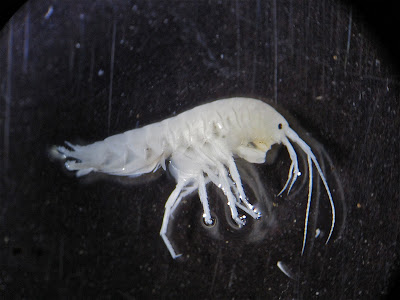Wednesday, February 9, 2011
Freshwater Crustaceans: Scuds and Sowbugs
I know, I know -- they're not "insects"! But I had so many co-volunteers when I was in StreamWatch who had never seen either of these, that I thought I'd do a short entry on them -- just in case any of those colleagues from StreamWatch are reading this blog.
Scuds (order: Amphipoda) and Sowbugs (order: Isopoda), along with Crayfish (order: Decapoda) are "Freshwater Arthropods," more specifically "Freshwater Crustraceans." I will not comment on crayfish:
if you haven't seen crayfish, I'm not sure why you're reading this blog!
Scuds and sowbugs (that's a sowbug at the top of the page) both have two pairs of antennae at the front of the head, and the head and first thoracic segment, in both cases, are fused to form a "cephalothorax." The following seven thoracic segments each has a pair of legs, with the abdomen being -- in the photo above -- the single, squarish segment at the tail end. Sowbugs are "dorsoventrally" flattened, meaning they are wider than they are "tall": the photo at the top of the page shows us a view from above; the photo below is a side view.
They're not very pretty -- and they're sort of slow as they move on the net: average size is, I'd say, 1/4" - 1/2".
Scuds, by contrast, are "laterally" flattened, meaning they're taller than they are wide. The legs show up very well on this example, as do the two pairs of antennae. Scuds, unlike sowbugs, are pretty fast on the net, and once you've put them into the tray, they're almost impossible to pick up again with the tweezers. Also, they're "sideswimmers," squirming about on their sides.
In StreamWatch we were not required to ID sowbugs to the level of family, but I think we always assumed they were Asselidae, the family most commonly found in North America. With scuds, we did ID them to family, but that had to be done in the lab -- so all of our samples were preserved. Most of our scuds were found to belong to two different families: Gammaridae and Crangonyctidae.
Sowbugs and scuds both live in slow-moving, shallow water -- and not the best water at that. Their tolerance values range from 6 to 8 depending on family ID. In which streams did we normally find them? Number one: Carroll Creek in Glenmore. I always told volunteers, if you want to see them, that's where you want to sample. Of course, we'd find the occasional scud here or there and the same for the sowbugs. But if you want to see them in significant numbers, Carroll Creek is the place to go.
When I go out to streams on my own, I often find lots of scuds in leaf packs in small, feeder streams in the fall. But if you want to catch one, you've got to be quick with the tweezers.
Subscribe to:
Post Comments (Atom)




No comments:
Post a Comment